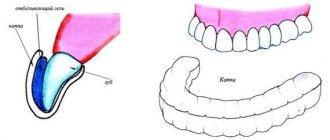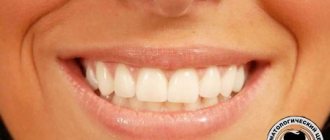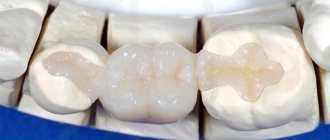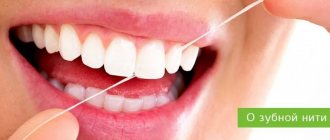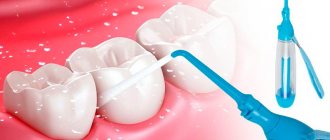Chief editor of the site:
Snitkovsky Arkady Alexandrovich
Chief physician of the professorial dentistry “22 Century”, dentist, orthopedic dentist
Author of the article:
Scientific team of dentistry “22 Century”
Dentists, candidates and doctors of medical sciences, professors
Plate prosthesis
A plate prosthesis is the most common of the simple and affordable methods of removable prosthetics for complete or partial absence of teeth. Let's look at the materials and stages of its manufacture.
Photopolymers in dentistry
Photopolymer for teeth - what is it and how exactly is it used in dentistry? This is a high-molecular compound that has the property of transitioning from a liquid to a solid state under the influence of ultraviolet radiation. The material was invented in the late 70s of the last century by employees of the American company Dart Industries Inc.
Photopolymer resins are intended for the manufacture of dentures; they are completely safe for medical use. With their help, 3D models are created at high speed. They are also used for filling teeth, allowing them to significantly improve their appearance.
Photopolymers have the following qualities: strength, durability, aesthetic appeal. A variety of shades allows you to choose the most suitable filling color. When choosing a material, you should focus on its optical, mechanical and physicochemical characteristics. These parameters are needed to adapt photopolymer resins for 3D printers.
Classification of photopolymer materials by level of filling (or by the ratio of filler and matrix)
- Macro-filled (filler content – 75-80%, particle size – from 5 to 100 microns).
- Microfilled (filler content – 40-70%, particle size – from 1 to 10 microns).
- Nanocomposites (filler content – 30-60%, particle size – from 0.0007 to 0.04 microns).
Different types of materials are used to restore different groups of teeth.
The Print Dent online store offers a wide range of high-quality photopolymer resins from well-known manufacturers: Detax. The products are intended for wide use in dental practice. The online store has a registration certificate that allows the use of materials for 3D printing in medicine.
Variety of photopolymer resins in the catalog:
- Dental Yellow/Clear – has hypoallergenic properties, used after finishing polymerization;
- Dental Sand – used for making temporary dental structures;
- Freeprint cast is a light-curing polymer for the generative production of objects using precision casting technology;
- Freeprint model UV – used for the manufacture of dental models, has maximum hardness and shape stability;
- Freeprint splint is a biocompatible photopolymer intended for the generative production of drilling templates for implantology, X-ray templates and bite splints.
Application of polymers in dentistry
All plastics for orthopedics can be divided into groups according to the functions they perform.
- Materials from which dentures are made
- Plastic compositions for impressions and forming models for casting, creating trays, protective caps and temporary crowns.
- Clinical agents – sealants, filling compounds and agents for adhesion at the junction of the material with the dental tissue.
There are signs that determine whether polymer can be used in dental prosthetics. The composition should not absorb water while constantly being in a humid environment. In a chemical compound, the residual amount of monomers that have not entered into the polymerization reaction is regulated. During use, they are washed away, having a harmful effect on the body. The dough for pressing should be homogeneous. Temperature and pressure during the process of molding and curing the workpiece affect the quality of artificial teeth and the absence of micropores. All these characteristics are met by special formulations. The basis of orthopedic plastic is a basic polymer. Fillers are substances that give the material special properties:
- Fillers – flour from silicon minerals with high hardness, glass, hydrosilicates.
- Plasticizers – impart elasticity and prevent aging in light.
- Dyes and pigments that create imitation color.
- Initiators and activators designed to continue the polymerization reaction of individual free radicals.
GOST determines that the total amount of fillers should not exceed 50%.
Chemical composition of photopolymers, contraindications to their use
The materials consist of various combinations of long and short monomers, oligomers, photoinitiators and additives. Various formulas can be created with a wide range of properties: transparent or colored polymers, flexible or rigid, viscous or heat-resistant.
Characteristics of the main components:
- oligomers and monomers – are the basis of the polymer and form a solid;
- photoinitiators - molecules that react to ultraviolet radiation and initiate a reaction;
- additives – visual and functional additions (pigments, inks, etc.).
Contraindications for the use of photopolymers
- Allergic reactions to individual components.
- Increased occlusal load.
- High degree of dental caries damage.
- The presence of inflammatory processes in the root.
- Poor oral hygiene.
- A tooth can only be restored with a crown.
Stages of manufacturing a plate prosthesis
- Conversation with the patient (it is necessary to clarify complaints, the presence of chronic diseases, allergic reactions, etc.);
- Examination of the oral cavity, assessment of the condition of soft tissues and level of hygiene;
- Additional studies (radiography, tests, etc., if necessary);
- Selection of design;
- Taking impressions from the upper and lower jaws;
- Making a plaster model, then a wax template with bite ridges;
- Trying on in the oral cavity, determining the relative position of the jaws, the color and shape of the teeth, choosing fixing elements (if there are preserved teeth);
- Strengthening models into an articulator, placing artificial teeth on a wax base, placing fixing elements in the base;
- Try-on in the oral cavity, correction if necessary;
- Replacement of wax with the final material, processing, polishing of the prosthesis;
- Fitting in the oral cavity, correction. Recommendations for care.
Plate dentures have proven themselves to be affordable, quick to manufacture and aesthetic designs.
Date of publication: September 20, 2020 Last update: September 22, 2022 © 2020 Professorial Dentistry “22 Century”. All rights reserved.
Mechanism of adhesion of composites to dentin
To obtain a strong adhesion, the following technique is used:
- Treatment of dentin with acid.
- Primer treatment.
- Application of hydrophobic adhesive.
- Insulation.
- Traditional cavity preparation.
- Treatment with 70% alcohol and ether.
- Gasket application.
- Application of etching gel.
- Application of a two-component hydrophobic adhesive.
- Filling the cavity.
- Final treatment of the cavity.
Requirements that must be observed when working with photopolymer
- The ultraviolet light source must be checked periodically, since if its physical properties deteriorate, the quality of the photopolymer will decrease.
- The carious cavity should be filled in layers, this will promote more complete polymerization.
- To prevent premature curing of the photopolymer, it must be protected from extraneous light sources during operation.
- To compensate for shrinkage, directional polymerization techniques should be used.
Good to know. It is necessary to limit the access of unauthorized persons and animals to photopolymer resins.
You can purchase 3D printers for dentistry in the Print Dent online store. These devices are used in dental offices and dental laboratories for the production of crowns, bridges, frames for casting and pressing ceramics, and other dental models. The 3D printers Asiga MAX (have high productivity with minimal dimensions) and Asiga PRO2 62 (designed for the production of large volumes of dental models and high-precision burnable and temporary orthopedic structures) are very popular among clients.
Mechanism of adhesion of composites to enamel
To achieve the required adhesion, the following technique is used:
- A bevel of 45° or more is formed, this will increase the active adhesion surface of the enamel and composite.
- The enamel is etched with 30% phosphoric acid for 15-60 seconds. As a result, organic plaque is removed, micro-roughness of the enamel is formed, and the marginal permeability at the enamel-photopolymer interface is reduced.
- Polymerization is carried out using enamel (hydrophobic) bonds based on the BIS-GMA monomer. Then processes are formed that will provide micromechanical adhesion of the enamel to the bond.
- An adhesive system is used.
- The tooth is filled.
- Final processing is underway.
3D scanning technology is actively gaining popularity in dentistry. The use of 3D scanners can significantly reduce costs in dental production, increase treatment efficiency and business profitability. Managers of the Print Dent online store will help customers select equipment taking into account their tasks.
Features of photopolymer fillings
A photopolymer filling is a flexible material that hardens over time, designed to fill and level dentin defects and restore hard dental tissues. The filling consists of a mixture of polymer and filler, its service life is 5 years or more. Due to a number of unique properties, photopolymer fillings are widely in demand in modern dentistry.
It is important to know. Photopolymer fillings can be placed on the front and back teeth.
The use of fillings allows you to solve the following problems:
- complete restoration of damaged teeth;
- change in the length and shape of teeth;
- securing the movable crown;
- restoration of hopeless teeth “from scratch” (only the root is used).
The disadvantages of photopolymers include shrinkage and marginal adherence, so they are not suitable for covering large tooth defects and cannot be used as an alternative to prosthetics.
Advantages of photopolymer fillings
- Rapid hardening in the oral cavity.
- Aesthetically attractive appearance.
- Excellent hold.
- Excellent polishability.
- A large selection of color palettes makes it easy to choose the desired tone.
- Possibility of completely restoring the shape of the tooth.
- Long service life.
- Minimal risk that the photopolymer will fall out or crumble.
- You can eat food almost immediately after the filling is installed.
Photopolymer materials hermetically seal sensitive tooth tissues. With their help, the dentist will be able to recreate the natural anatomy of the teeth, while the chewing load will be distributed evenly. The photopolymer filling will blend with the healthy areas of the tooth, guaranteeing an irresistible smile.
Artificial teeth
Laminar dentures
For laminar dentures, artificial teeth are made of plastic.
There are frontal (front) and chewing (root) groups, produced in sets in headsets.
Plastic teeth are very similar in appearance to the enamel of natural teeth. During production, you can vary the color and shade. Artificial teeth are firmly connected to the base due to the homogeneity of the material (their connection occurs during polymerization of the base plastic). They are also easy to adjust both by a technician in the laboratory and by a doctor when handing over the prosthesis. Headsets are available in several styles and shades, many combinations are possible. Due to this, it is possible to harmoniously select and manufacture a prosthesis according to the individual parameters of the face.
Over time, the technology for making artificial teeth has progressed.
proposed to produce acrylic artificial teeth using the injection-compression method (continuous injection of material during polymerization to compensate for its shrinkage, followed by compaction of the material to a homogeneous state). This makes them incredibly durable.
The Ukrainian company produces artificial teeth in the form of a set in Estedent, Estedent-02. They have the following positive properties: imitation of the anatomical shape and color of the tooth; high strength indicators; fluorescent effect (both in natural and artificial lighting). Estedent-D is used for prosthetics for children during the period of temporary and mixed dentition.
“Executive” artificial teeth (“Dentsply”, USA) have five distinct shade zones, which will allow you to imitate natural teeth as accurately as possible.
Also in our country, headsets “Megastar” (Great Britain), “Ivoclar” (Liechtenstein), etc. have found use.
When selecting artificial teeth, not only the color of natural teeth (if any) is taken into account, but also the shape of the patient’s face and constitution. Thanks to a wide selection of artificial teeth in color and shape, an individual approach to each clinical case is possible.
Dental restoration with photopolymer
The latest generation of photopolymers allows you to completely restore a tooth and recreate its natural shape, rather than simply closing an existing defect. But for this, the dentist must have the appropriate skills to work with such material. High-quality photopolymer fillings cannot be cheap, because with their help you can achieve complete restoration of the aesthetics and function of the tooth. As a rule, such fillings do not fall out, but if this happens, you should think about the quality of the dentist’s work.
Installation of the seal is carried out in several stages:
- The dentist removes the affected tissue, leaving healthy dentin intact. To ensure that the procedure is painless and does not cause any discomfort to the patient, anesthesia can be used.
- The tooth cavity must be dried and treated with an acid-containing composition.
- After this, the doctor applies an adhesive system, which will act as a link between the filling and the tooth tissue. To quickly harden the material, use the light of an ultraviolet lamp.
- The photopolymer filling is applied in layers. This allows you to achieve the highest strength and the most natural shade. When installing a filling, it is necessary to completely prevent liquid from entering the tooth.
- The final stage is processing the filling in order to achieve the correct bite.
Good to know. High-quality tooth restoration will not be noticeable to others.
Errors in working with photopolymers
When working with dental polymers, the following mistakes should not be made:
- insufficient treatment of the carious cavity;
- lack of contact point with the adjacent tooth;
- poor-quality fixation of the matrix, which results in the formation of an overhanging edge of the filling;
- breaking off the enamel edges of the carious cavity;
- formation of an enamel bevel on the occlusal surface during preparation;
- incorrect choice of therapeutic and insulating cushioning materials.
When working with photopolymer resins for 3D printers, the following mistakes are often made:
- the selected photopolymer does not match the wavelength of the emitter or its dosage is insufficient;
- the light-sensitive photopolymer is exposed to sunlight and the light of fluorescent mercury lamps, which leads to its thickening;
- The composition of photopolymer resins is incorrectly selected, as a result of which the finished models crack and break when removed.
Clasps
Clasp denture with clasps
In case of partial absence of teeth, one of the ways to fix the prosthesis in the oral cavity is the presence of clasps. They are usually made of metal. They tightly cover the tooth, can only serve as a retaining element, and also act as a support, that is, transmit chewing pressure to the tooth. Noticeable when talking and smiling.
Clasps made of elastic material (nylon dentures) can only perform a retaining function. Excellent aesthetics, but unreliable and can become deformed and break.
